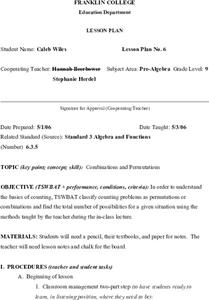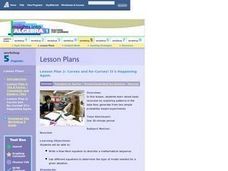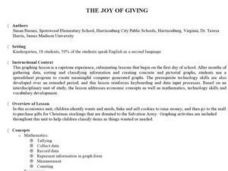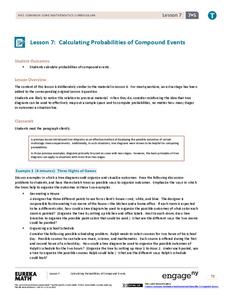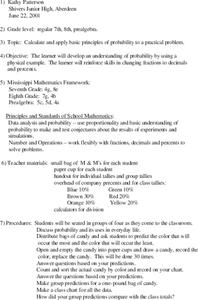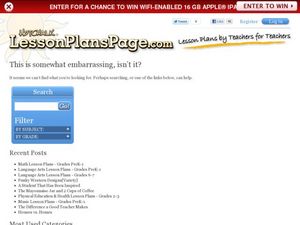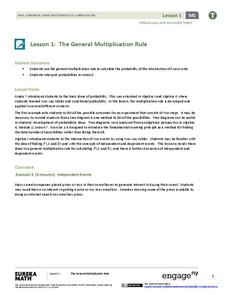Curated OER
Enumeration
In this calculus lesson, students review counting using the principles of Enumeration. They use random selections to count and convert word problems and count. There are 21 problems with an answer key.
Curated OER
Who Are We? An Introduction to the Life Within Our Bodies
Students examine cell structure, cell division, and the basic structure of DNA. They read and discuss a case study of DNA research, answer discussion questions, role-play the process of mitosis, and complete a DNA Fact or Fiction worksheet.
Curated OER
Introduction to Contracts
Students are introduced to the concept of contracts in street law. In groups, they compare and contrast contract law with tort law. They identify the basic concepts of each and view examples to see the concepts in use. They also disccuss...
Curated OER
Tree Leaves: Determining the Characteristics They Share in Common
Students use their basic knowledge of dendrology concepts and terms. In this tree leaf lesson students divide into groups and determine which characteristics go with what plant.
Curated OER
Combinations And Permutations
Seventh graders investigate the mathematical concept using a lecture format. The lesson includes a classroom management section with suggestions for lesson execution. Students write a definition for the Fundamental Counting Principle....
Curated OER
Curses and Re-Curses! It's Happening Again.
Students study basic recursion by exploring patterns in the data they generate from two simple probability-based experiments. In the first, students flip a coin to discover how many times they must flip it before it lands on "heads."...
Curated OER
The Joy of Giving
Children identify wants and needs, bake and sell cookies to raise money, and then go to the mall to purchase gifts for Christmas stockings that are donated to the Salvation Army. They then perform Graphing activities to help children...
Curated OER
Lesson Plan on Wants and Needs
First graders examine and discuss the difference between what they need to live and what they want. They examine pictures from magazines and newspaper ads, distinguishing between whether they are wants or needs.
Curated OER
Needs and Wants
Students examine the difference between needs and wants. In this consumption activity, students illustrate their needs and wants and discuss their own reasons for buying things. They also discuss the connection between their choices...
Curated OER
What Do You Need?
Students discover the difference between needs and wants. Using pictures, they develop a list of the needs and wants shown in each. They answer and discuss the answers to the questions as a class to end the lesson.
Curated OER
Observing Plants
Students identify how plants affect the survival of a caterpillar and what plants need to survive. They plant three bean seeds in the three containers, placing two containers at a sunny window and the third one in a dark closet and label...
EngageNY
Calculating Probabilities of Compound Events
Use tree diagrams with multiple branches to calculate the probabilities of compound events. Pupils use tree diagrams to find the sample space for probability problems and use them to determine the probability of compound events in the...
Curated OER
Activity: Gummy Bear Genetics
Who's your Daddy ... and Mommy for that matter? Given a first-generation group of gummy bear offspring, young scientists must determine which bears are their parents. An activity worksheet covers the differences in genotypes and...
Curated OER
Probability using M & M's
Using M & M's candies, young statisticians predict the color distribution in a packet of candies and test their predictions against their group and the larger class. A review of converting between fractions, decimals, and percents...
Curated OER
Probability: The Study of Chance
Students conduct an experiment, determine if a game is fair, and collect data. They interpret data, then display line graph. They conduct analysis of game for probability.
Curated OER
Measurement
Students create two prisms out of the same paper. They calcuate the number of centimeter cubes needed to fill each prism. They discover the concept of volume.
Curated OER
Solar Systems Models Foldable Question Sheet
In this solar system worksheet, students use foldable models they made of the planets to answer questions about each planet. They answer questions about the theories and predictions made in our history about the solar system and answer...
Curated OER
Too Many Apostrophes
In this apostrophes worksheet, students read sentences and insert or take out apostrophes that are needed or not needed. Students complete 12 problems.
Curated OER
Do You Feel Lucky?
Students explore probability by using games based on probable outcomes of events. They name all of the possible outcomes of an event and express the likelihood of such an event occurring.
Curated OER
Physical Education Unit Plan: Soccer - Lesson 4
PE unit plan: soccer – has 10 lessons. These Lesson four of this soccer unit focuses on passing and receiving the ball. Learners will practice passing a soccer ball, first directly to a partner, and then progressively to open spaces...
NOAA
Vertebrates I
I spy a spine. The 19th installment of a 23-part NOAA Enrichment in Marine sciences and Oceanography (NEMO) program explores vertebrate species, such as sharks and other fish. Learners take part in an activity evaluating the...
Virginia Department of Education
Moles Lab Activities
Want my name and number? It's 6.0221415 times 10 to the 23rd, and my name is Avogadro. Providing nine different activities, experiments, and labs, this lesson plan keeps Avogadro relevant to your class all year long.
EngageNY
The General Multiplication Rule
In the first installment of a 21-part module, scholars build on previous understandings of probability to develop the multiplication rule for independent and dependent events. They use the rule to solve contextual problems.
Curated OER
Bridges
Students compare and contrast the three primary types of bridges. In this technology lesson plan, students design and build a bridge that spans 25 cm. They test their design and present the results to class.




